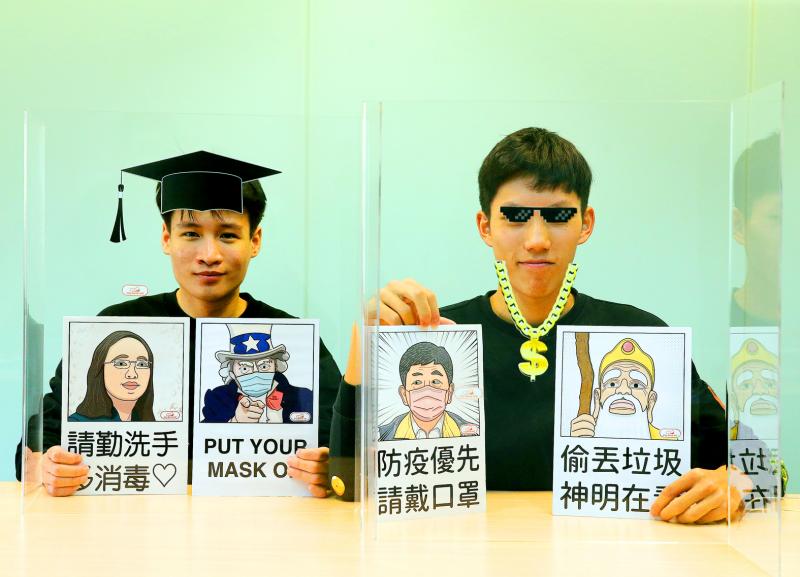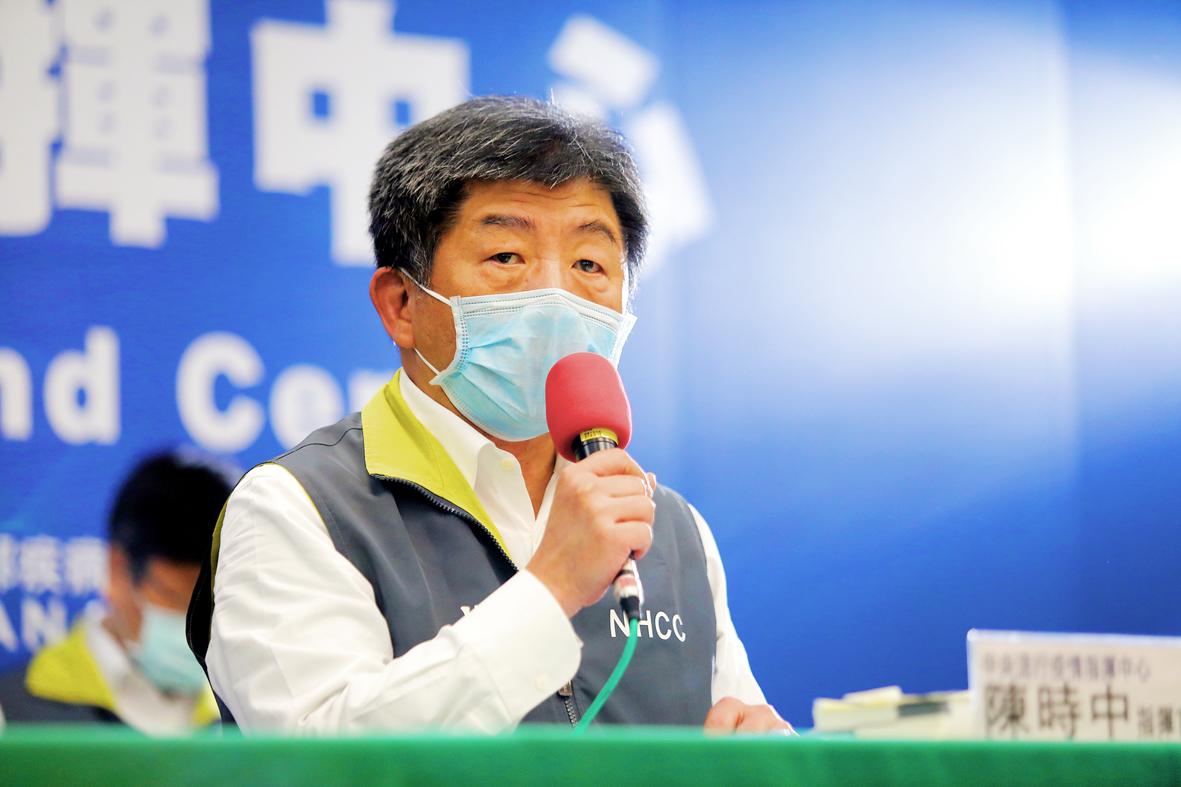A new COVID-19 case related to the navy’s “Friendship Flotilla” was reported by the Central Epidemic Command Center yesterday, bringing the cluster infection to 29 cases.
The patient is a man in his 20s who had been on the Panshih — one of three vessels that made up the flotilla, Minister of Health and Welfare Chen Shih-chung (陳時中) said at the center’s daily briefing in Taipei.
The flotilla returned to Taiwan on April 9 after visiting Palau from March 12 to 15. Crew members disembarked on Wednesday last week.

Photo: CNA
The patient on Saturday last week entered a quarantine facility and initially tested negative for COVID-19, said Chen, who heads the center.
He began experiencing symptoms on Sunday, including a sore throat and cough, and yesterday was confirmed as having the novel coronavirus after being tested for a second time on Tuesday, he said.
Twenty-nine people on the Panshih had tested positive for COVID-19 as of the time of the briefing, he said, adding that the center had identified 1,237 people who had been in contact with the confirmed cases.

Photo: CNA
In a statement later yesterday, the center said that it was gathering polymerase chain reaction and antibody test results, as well as analyzing the onset and course of symptoms in confirmed COVID-19 cases, and cases who tested positive for antibodies, to understand the time line and origin of the infections on the ship.
The nation as of yesterday had recorded 427 cases of COVID-19, including six deaths.
Meanwhile, the center said that it was extending two air travel policies — one restricting flights between Taiwan and China, and the other banning flight transfers.
The former was to expire on Wednesday next week, while the latter was due to end the following day, the center said.
When the measures would be lifted would depend on the global COVID-19 pandemic, it said.
The Ministry of Transportation and Communications on Feb. 10 temporarily banned passenger flights between Taiwan and China with the exception of those to and from five Chinese airports: Beijing Capital International Airport, Shanghai Pudong International Airport, Shanghai Hongqiao International Airport, Xiamen Gaoqi International Airport and Chengdu Shuangliu International Airport.
In related news, Chang Shan-chwen (張上淳), convener of the center’s expert advisory panel, provided an update on the nation’s testing regime.
To protect healthcare workers, as well as their patients, many of whom are elderly or have weak immune systems, the center on Feb. 27 began testing all healthcare workers showing symptoms of pneumonia, Chang said.
Late last month, the center expanded the criteria to all healthcare workers with a fever or any respiratory symptom, he said.
From March 30 to Wednesday last week, the center had tested 1,852 healthcare workers, all of whom tested negative for the coronavirus, he added.

The US government has signed defense cooperation agreements with Japan and the Philippines to boost the deterrence capabilities of countries in the first island chain, a report by the National Security Bureau (NSB) showed. The main countries on the first island chain include the two nations and Taiwan. The bureau is to present the report at a meeting of the legislature’s Foreign Affairs and National Defense Committee tomorrow. The US military has deployed Typhon missile systems to Japan’s Yamaguchi Prefecture and Zambales province in the Philippines during their joint military exercises. It has also installed NMESIS anti-ship systems in Japan’s Okinawa

‘WIN-WIN’: The Philippines, and central and eastern European countries are important potential drone cooperation partners, Minister of Foreign Affairs Lin Chia-lung said Minister of Foreign Affairs Lin Chia-lung (林佳龍) in an interview published yesterday confirmed that there are joint ventures between Taiwan and Poland in the drone industry. Lin made the remark in an exclusive interview with the Chinese-language Liberty Times (the Taipei Times’ sister paper). The government-backed Taiwan Excellence Drone International Business Opportunities Alliance and the Polish Chamber of Unmanned Systems on Wednesday last week signed a memorandum of understanding in Poland to develop a “non-China” supply chain for drones and work together on key technologies. Asked if Taiwan prioritized Poland among central and eastern European countries in drone collaboration, Lin

Renewed border fighting between Thailand and Cambodia showed no signs of abating yesterday, leaving hundreds of thousands of displaced people in both countries living in strained conditions as more flooded into temporary shelters. Reporters on the Thai side of the border heard sounds of outgoing, indirect fire yesterday. About 400,000 people have been evacuated from affected areas in Thailand and about 700 schools closed while fighting was ongoing in four border provinces, said Thai Rear Admiral Surasant Kongsiri, a spokesman for the military. Cambodia evacuated more than 127,000 villagers and closed hundreds of schools, the Thai Ministry of Defense said. Thailand’s military announced that

CABINET APPROVAL: People seeking assisted reproduction must be assessed to determine whether they would be adequate parents, the planned changes say Proposed amendments to the Assisted Reproduction Act (人工生殖法) advanced yesterday by the Executive Yuan would grant married lesbian couples and single women access to legal assisted reproductive services. The proposed revisions are “based on the fundamental principle of respecting women’s reproductive autonomy,” Cabinet spokesperson Michelle Lee (李慧芝) quoted Vice Premier Cheng Li-chiun (鄭麗君), who presided over a Cabinet meeting earlier yesterday, as saying at the briefing. The draft amendment would be submitted to the legislature for review. The Ministry of Health and Welfare, which proposed the amendments, said that experts on children’s rights, gender equality, law and medicine attended cross-disciplinary meetings, adding that